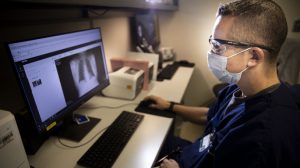Expedited Care
September 30, 2021 | Tom Wilemon
When people go to an emergency room after being injured, suspicious images may show up on their imaging scans that are unrelated to their injuries but may be indicative of cancer. A team at Vanderbilt University Medical Center recently established a better process for ensuring these patients receive follow-up diagnostic care, an initiative that is already receiving national recognition.
The new, expedited process establishes a streamlined system and clearly defined chain of responsibility for following up on these incidental findings. It utilizes eStar, VUMC’s Epic-based software, to send automatic alerts when patients are identified who need the diagnostic care.
“The patients are who ultimately benefit from this,” said Tyler Barrett, MD, MSCI, executive medical director of Vanderbilt Emergency Services and Vanderbilt University Adult Emergency Department. “It really started from us identifying a need many years ago and figuring out a way to handle the follow-up for these patients with incidental findings. It has gone through multiple iterations, and we’ve ultimately landed on a simple, efficient and reliable process.”
The system meets patients’ needs by matching them with the person who can best handle their cases. If the patient is visiting Nashville, an Emergency Department case manager routes that person to a cancer center where they live.

Tyler Barrett, MD, MSCI, studies an X-ray image. Photo by Susan Urmy.
“Before, if a patient came to the Emergency Department and had an unrelated incidental finding, it was the responsibility of the ED or the patient to reach out and find the appropriate provider follow-up,” said Katharine “Katie” Klar, RN, who supervises the V-ISTA team (Vanderbilt-Ingram Service for Timely Access).
Clinicians with both the Emergency Department and Vanderbilt-Ingram Cancer Center (VICC) recognized the need to improve the system. Nick Garland, MS, an administrative fellow embedded within VICC, was given the task of shepherding the initiative.
“We brainstormed for ideas — what we thought the ideal process would be like, what the goals were and the next steps,” Garland said. “I acted as a liaison between all these groups to connect all the dots and envision what the process would look like from an operational perspective.”
Klar presented VUMC’s system for handing incidental findings to the Oncology Nursing Society annual meeting in April, while Garland is scheduled to speak about it in October at the Association of Community Cancer Centers business summit.
Discussions are underway on how VUMC can share the system with other hospitals that utilize Epic-based software. Additionally, members of the team are working to set up a similar system to better expedite follow-up diagnostic care for patients with incidental findings in settings outside of the Emergency Department.
